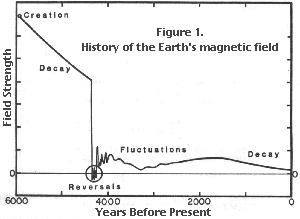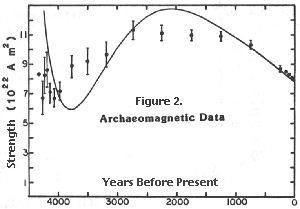
The earth's magnetic field has been a mystery to man ever since 13th-century philosophers first noticed lodestones (magnetic rocks) turning north. [1] In 1600, A.D. William Gilbert, Queen Elizabeth's physician, shed light on the mystery by showing that "the terrestrial globe itself is a great magnet." [2] Today, scientists think the earth is an electromagnet ; the source of the magnetic field is probably a large electric current—billions of amperes—circulating in the earth's fluid core. But there is still a mystery today: How did the current get started, and what keeps it going? Scientists, who assume that the earth is old, conjecture that complicated flows of the fluid in the core somehow started the current and have maintained it for billions of years. However, such "dynamo" theories are complex, implausible, and incomplete. In the last two decades, they have run into serious problems from magnetic observations on earth [3] and in the solar system. [4]
In 1971, Dr. Thomas Barnes, a creationist physicist, proposed that nothing keeps the current in the core going except its own inertia. [5] His simple and rigorous "free-decay" theory would mean that the current is running down slowly, like a flywheel without a motor; thus the strength of the earth's magnetic field would be steadily decreasing over the centuries. [6] Barnes cited some historical data [7] (not well known at the time) showing that the overall strength of the earth's field has indeed steadily declined by about 7% since 1835, when it was first measured. The decay rate depends on the electrical resistance of the earth's core, and the observed rate is consistent with the estimated resistance of materials at core temperatures and pressures. [6], [8] The field strength should decrease by a constant percentage each year, and the data are consistent with such a decrease, implying that the field loses half its strength every 1400 years. Such a rapid decay could not have continued for more than about 10,000 years; otherwise the initial strength of the field would have been impossibly high. Since the field probably started when the earth was formed, the present rapid decay of the field is strong evidence for a young earth. Old-earth proponents, however, correctly point out that the earth's magnetic field has not always decayed smoothly. [9], [10] Archaeomagnetic (magnetism of pottery, bricks, etc.) data indicate that the present steady decay started around 500 A.D. For several millennia before that, the overall strength of the field had fluctuated up and down significantly. Paleomagnetic (magnetism of geologic strata) data provide persuasive evidence that the field reversed its direction scores of times while the fossil layers were being laid down. [11] Since the field has changed so violently in the past, old-earthers ask, how do we know the present decrease in the field is a decay, not a fluctuation or a reversal? Furthermore, if a "dynamo" process did not start up the current in the core (as is becoming obvious by the problems with the theory), then how did the current originate? 
History of the Field
This article summarizes five technical papers I have published to answer such questions. The discriminating reader will want to read them to understand more fully the model which is only summarized below.
 Figure 1 shows what I think is the history of the earth's magnetic field. It can be divided into the following five episodes: (1) Creation. In 1983, 1 pointed out that when God created the earth's original atoms He could have easily created the earth's magnetic field also, merely by bringing the atoms into existence with the spin axes of their nuclei all pointing in the same direction. [12] Many atomic nuclei spin, and thereby generate tiny magnetic fields. There were so many spinning nuclei in the earth at creation that, if aligned, their fields would have added up to a large field of sufficient magnitude. As thermal collisions disoriented the nuclear spins, the laws of electricity predict a startup of an electric current within the core of the earth to sustain the field. The resulting initial field strength is consistent with the present geomagnetic data and a 6000-year age for the field. Thus we have a plausible explanation for how the current in the core got started. In 1984, I extended my theory to the sun, moon, and planets, [13] explaining the magnetic fields measured by the space probes of the last few decades, and predicting the approximate strength of the fields of Uranus and Neptune. In 1986, Voyager 2 verified the Uranus prediction, [14] and we should find out about Neptune in early 1990. (2) Pre-flood decay. After creation (and the Fall), the electric current in the earth's core would decay slowly, as would the field, for 1656 years, until the Genesis flood. During this period, the field would have been more than ten times stronger than it is today, thus shielding the earth from cosmic ray particles more effectively, reducing the production of carbon 14 in the pre-flood atmosphere, and making the earth a healthier place. [5] (3) Rapid reversals during the flood. In 1986, I suggested that there was a powerful release of energy in the earth's core at the beginning of the Genesis flood, and that the resulting strong movements in the core field produced rapid reversals of the earth's magnetic field, about one per week, during the year that the flood was laying down the fossil layers at the earth's surface. General physical laws allow rapid reversals, a likely physical mechanism exists to cause the reversals, and observations of the sun's magnetic field demonstrate reversal cycles in nature today. This rapid-reversal model not only explains the general features of the paleomagnetic data, but also some specific features which have puzzled evolutionists. [15] (4) Post-flood fluctuations. The disturbances in the core fluid during the flood would disrupt the electric current, chopping much of it up into small swirls oriented in different directions. Then the earth's field during and after the flood would not have the simple "dipole" (two poles, north and south) shape it has today. Instead, it would have a more complex shape, with strong "higher-order" components: quadrupole (four poles), octopole (eight poles), etc. Paleomagnetic data confirm the existence of such components in the field in the past. Standard electromagnetic theory predicts that, after the flood, the higher-order components would die away faster than the dipole part. Because the higher-order components can have either polarity, the strength of the field would fluctuate up and down, as different components died away at different rates.
 Figure 2 shows world-averaged archaeomagnetic data. [16] Since the dates conventionally assigned to the data points are based on radiocarbon dating, I have plotted the data on a time scale crudely corrected for changes in the percentage of carbon 14 in the atmosphere since the flood. The curve shown is a statistical fit using just the three simplest of dozens of possible components. The data need to be re-analyzed, allowing for a more complex field shape, but the curve fits the main features of the data, in particular, an initial rise and fall, the broad maximum at about the time of Christ, and the subsequent, steady decay. [15] (5) Recent decay. Around 500 A.D., the last remaining higher-order component became small compared to the main dipole component, and the field decayed smoothly after that. 
Conclusion
Though complex, this history of the earth's magnetic field agrees with Barnes' basic hypothesis, that the field has always freely decayed. I have merely made explicit two features which were always implicit in the free-decay theory: (a) that motions in the core fluid can disturb the field, and (b) higher-order modes of decay are possible. Both of these features have a firm basis in theory, experiment, and natural phenomena. In contrast to dynamo theories, the reversals and fluctuations I picture dissipated energy. The field has always been losing energy despite its variations, so it cannot be more than 10,000 years old. We now have simple explanations for the field's origin, history, and present state. In this light, the earth's magnetic field is no longer a mystery; it is a testimony of God's handiwork.

|
References
1. Peregrinus, Petrus. Epistola de Magnete (1279). Trans. by Silvanus P. Thompson, Epistle of Peter Periginus of Maricourt, to Sygerus of Foucaucourt, Soldier, Concerning Magnets (London: 1902). Return to Text
2. Gilbert, William. De Magnete (1600). Trans. by P. Fleury Mottelay in Great Books of the Western World, Vol. 28, R.M. Hutchins, ed. (Chicago: Encyclopedia Britannica, 1952). Return to Text
3. Lanzerotti, L.J., et al. "Measurements of the large-scale direct-current earth potential and possible implications for the geomagnetic dynamo," Science 229 (5 July 1985) 47-49. Return to Text
4. Parker, E.N. "Magnetic fields in the cosmos," Scientific American 249 (Aug. 1983) 44-54, see remarks on Mercury and Mars, p. 52. Hood, L.L. "The enigma of lunar magnetism," EOS 62 (21 April 1981) 161-163. Dirscoll, E. "That magnetic moon: How did it get that way?" Science News 101 (27 May 1972) 346-347. For comments, see ref. 13. Return to Text
5. Barnes, T.G. "Decay of the earth's magnetic moment and the geochronological implications," CRSQ 8 (June 1971) 24-29. Return to Text (first occurance)
6. — "Electromagnetics of the Earth's field and evaluation of electric conductivity, current, and joule heating of the earth's core," CRSQ 9 (Mar. 1973) 222-230. Decay rate implies conductivity of 40,000 mho/m. Return to Text (first occurance)
7. McDonald, K.L. and R.H. Gunst. "An analysis of the earth's magnetic field from 1835 to 1965," ESSA Technical Report IER 46-IES 1 (July 1967) U.S. Govt. Printing Office, Washington, D.C., Table 3, p. 14. Return to Text
8. Stacey, F.D. "Electrical resistivity of the earth's core" Earth and Planetary Science Letters 3 (1967) 204-206. Likely core materials imply conductivity of roughly 33,000 mho/m, agreeing with ref. 6. Return to Text
9. Young, D.A. Christianity and the Age of the Earth (Grand Rapids: Zondervan, 1982) pp. 117-124. Return to Text
10. Dalrymple, G.B. "Can the earth be dated from decay of its magnetic field?" Journal of Geological Education 31 (March 1983) 124-132. Return to Text
11. Humphreys, D.R. "Has the earth's magnetic field ever flipped?" CRSQ 25 (Dec. 1988), in press. Return to Text
12. —"The creation of the earth's magnetic field," CRSQ 20 (Sept. 1983) 89-94. Return to Text
13. —"The creation of planetary magnetic fields," CRSQ 21 (Dec. 1984) 140-149. Return to Text
14. —"The magnetic field of Uranus," CRSQ 23 (Dec. 1986) 115. Return to Text
15. —"Reversals of the earth's magnetic field during the Genesis flood," Proceedings of the First International Conference on Creationism, Vol. 11 (Pittsburgh: Creation Science Fellowship, 362 Ashland Ave., 1986) 113-126. Return to Text (first occurance)
16. Merrill, R.T. and M.W. McElhinney. The Earth's Magnetic Field (London: Academic Press, 1983) 101-106. Return to Text
 |

